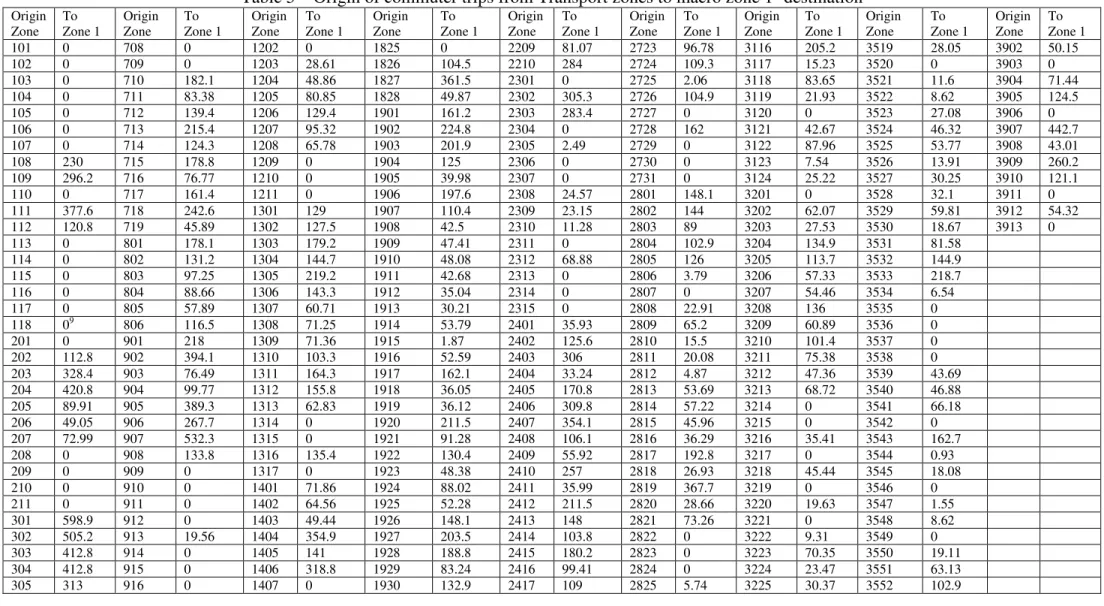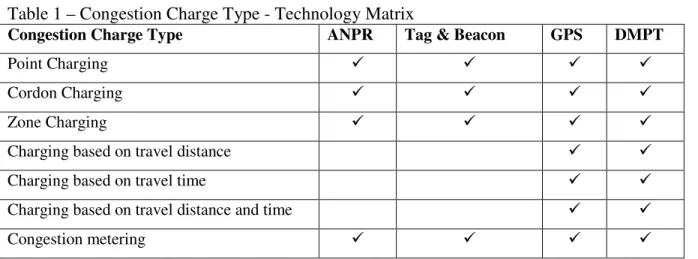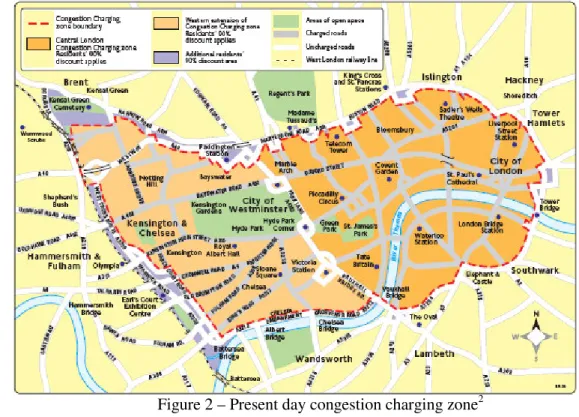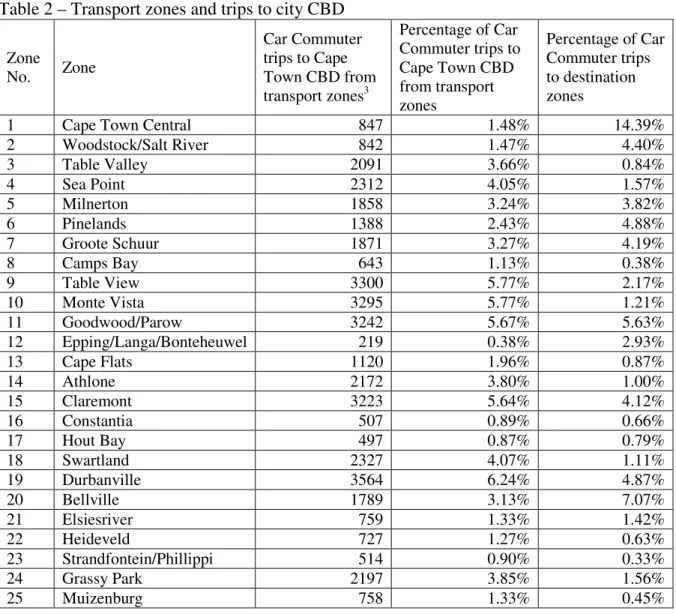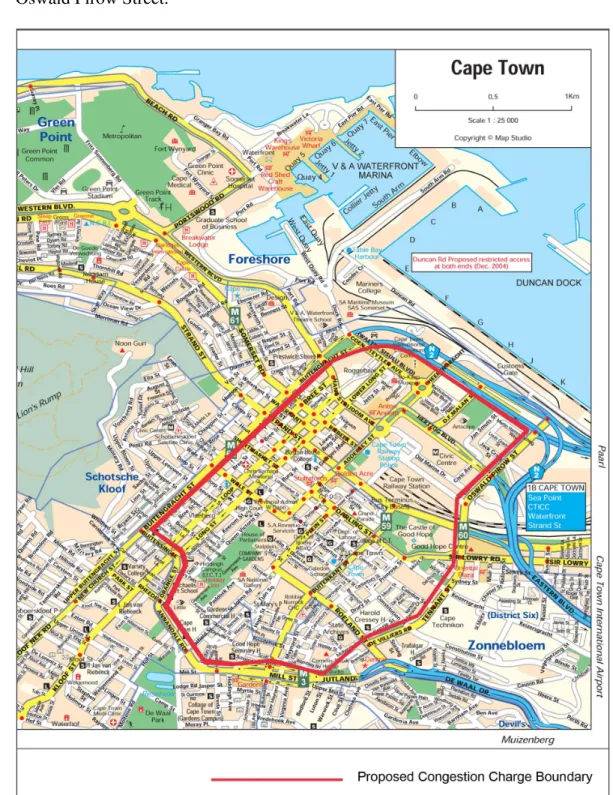The study found that of the types of congestion charging available, a simple cordon charge around the central business district (CBD) was the most feasible. Regarding the toll payment system, it was found that currently, a manual payment system would be more suitable for the city than a tag and beacon system.
Background
One of the guiding principles of land transport policy in South Africa has been that of user charging where appropriate and feasible (Department of Transport, 1996). This level of targeting was later removed in the publication of the Western Cape Provincial Transport Policy White Paper in May 1997, however, it stated that a modal split in favor of public transport would be actively pursued.
Problem Statement
Hypotheses
Research Objectives
Study Limitations
Assumptions
The elasticities used reflect the cost of travel, car ownership and the quality and provision of public transport. Where car ownership is predominantly among high and middle income earners and the public transport poor, the elasticities are low.
Preliminary Literature Review
It was reported that there was a 47% reduction in traffic volume within the first month of introduction. Following the implementation of the number plate restriction, there was an initial 20% reduction in traffic volumes.
Research Design and Methodology
This informed what type of congestion charge might be most applicable to Cape Town. It also provided insight into the various technologies that could be considered for use in the municipality.
Chapter Outline
Anecdotally, the current poor quality of public transport may have a negative impact on the acceptance of congestion charges. The data was also used for indicative calculation of the level of traffic reduction that could be expected.
Introduction
Travel Demand Management
Congestion Charging
Technology
- Automatic Number Plate Recognition (ANPR)
- Tag and Beacon
- Global Positioning Systems (GPS)
- Digital Mobile Phone Technology (DMPT)
Charging technology relates to the mechanisms available to drivers/companies that will be used to pay the charge. It was ideal for cordon loading and as an enforcement component of the marker and beacon system. A marker and beacon system can be a charging system as well as part of the enforcement system.
Depending on the type of tag, the beacon can either check the validity of the tag and its value (in the case of a prepaid system) or read a billing address (in the case of a postal travel system). However, this would depend on the geographical structure of the city and the presence of such infrastructure in the charging area.
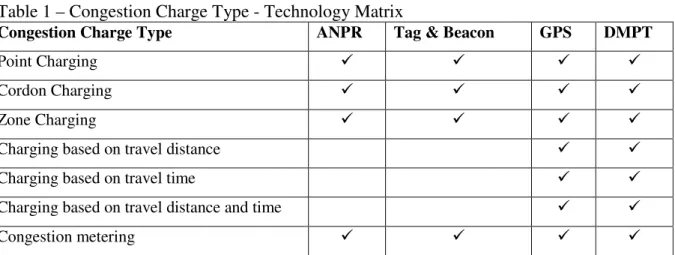
Examples of congestion charging approaches
Singapore
- Successes and Shortcomings of the ALS/RPS
- ERP
- Operational and technical features of ERP
- The structure of ERP charges
As noted above, the initial result of the ALS was a 44% reduction in the volume of traffic entering the area during restricted time periods. This would be limited in the case of Cape Town due to the geographical location of the city; and. The introduction of ALS has also resulted in underutilization of major roads in the CBD and redistribution of congestion in terms of time and location.
There has been an increase in the number of taxis and good vehicles on the expressways have increased. Singapore's congestion charge illustrates that charging does not need to be technologically sophisticated.
London
TfL reported that in the period prior to the introduction of congestion charging in 2003, travel speeds in central London were 13 km/h, similar to what it was 100 hundred years ago (TfL website). One of the driving factors when considering the type of congestion charge was the time frame in which it would be implemented and the enforcement technology that would be used. The payment of the fee could be made at approved newsagents, online and via SMS.
The early success of the congestion charge led to the then Mayor of London, Ken. The re-consultation on the western extension zone, introduced in 2005, and if found unfavorable by the public and stakeholders, could result in the removal of the western extension zone; and.

Durham
The introduction of a billing system, whereby motorists are not fined if they do not pay on the day itself. It illustrates that, just like in Singapore, the charging system does not have to be complicated.
Chapter Summary
Introduction
Research Design
Qualitative Research
Quantitative Research
Research Methodology
The difference can be attributed to Litman elasticities that are based on cities where street pricing, in one form or another, has been operational for a period of time. This was based on international case studies as well as the literature reviewed as part of this research. Exceptions were also identified, as the case studies revealed that a compromise would have to be made as it was not practical to apply a flat fee.
To determine the potential traffic reduction, a 43 x 1 OD matrix based on trips to the CBD was used. Parking charges were based on R900 per month in 2008, as listed in the current commercial property listings in the CBD.
Chapter Summary
The weighted average travel costs were then used in the travel demand elasticity formula used in this study to calculate the potential reduction in traffic. Where η = elasticity of demand Q1 = volume of traffic before Q2 = volume of traffic after P1 = travel cost before P2 = travel cost after.
Introduction
Many companies are based in these areas, so the distribution of daily car trips was not surprising.
Type of congestion charge
Exemptions and Discounts
As with all cities that have implemented congestion charges, there were certain types of drivers or vehicles that were either exempt from the charge or qualified for a reduced rate. For Cape Town it is recommended that discounts are not used as the cordon area is small and the Cape Town Public Transport Interchange is located within it. The consequence of these exemptions would be to strengthen public transport as a viable alternative to the use of cars while encouraging its use.
When exemptions are extended to other groups of road users, usually with the aim of gaining public acceptance, the effectiveness of the scheme could be called into question.
Charge area
Technology
Therefore, it is not currently considered a viable option for Cape Town, and more research should be done on addressing these challenges. It is recommended that the City consider a sign and beacon system as a later stage if the City pursues a distance-based congestion charging system. Therefore, for the introduction of a congestion charge, it is recommended that a payment system similar to the one currently operating in London would be the most viable.
The payment of the congestion charge for vehicles entering the charge area can be made by telephone, online or at approved dealers, local shops and post offices.
Enforcement
There may initially be a high level of non-matches due to drivers not being registered and providing incorrect details at the time of paying the levy or illegal vehicles entering the levy zone. In the case of illegal vehicles caught on camera, this information may be passed on to the traffic department or relevant authority to follow up. As in the case of London, the visual impact of road equipment must be considered and, where possible, minimized.
Figures 3 and 4 illustrate the primary cameras along with potential road markings and signage, while Figure 5 illustrates the supplementary cameras for additional enforcement. The visual impact on the city's streetscape would probably be minimal, as the primary cameras could be placed at the junctions on the border and the supplementary ones could be kept to a minimum and in places where they would be least intrusive.
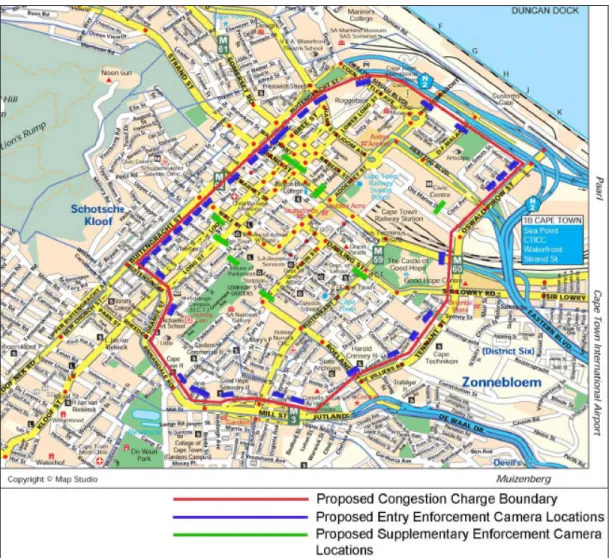
Traffic Reduction
It reflects various charging rates to compare the level of traffic reduction that can be achieved, based on costs and transport elasticities. The City's Draft TDM Strategy discusses congestion charges as a TDM measure and emphasizes that before it can be introduced, ITS must first be further developed. Although the City is undertaking a BRT initiative, which may mitigate the socio-economic impact, it may not be seen as an attractive alternative for high-income drivers.
The first is an upgrade of the city's public transport system, which even if the City. However, the City's Draft TDM strategy also seeks to promote the use of high-occupancy vehicles, which some may view as a more attractive modal choice and as an alternative to paying a congestion charge.
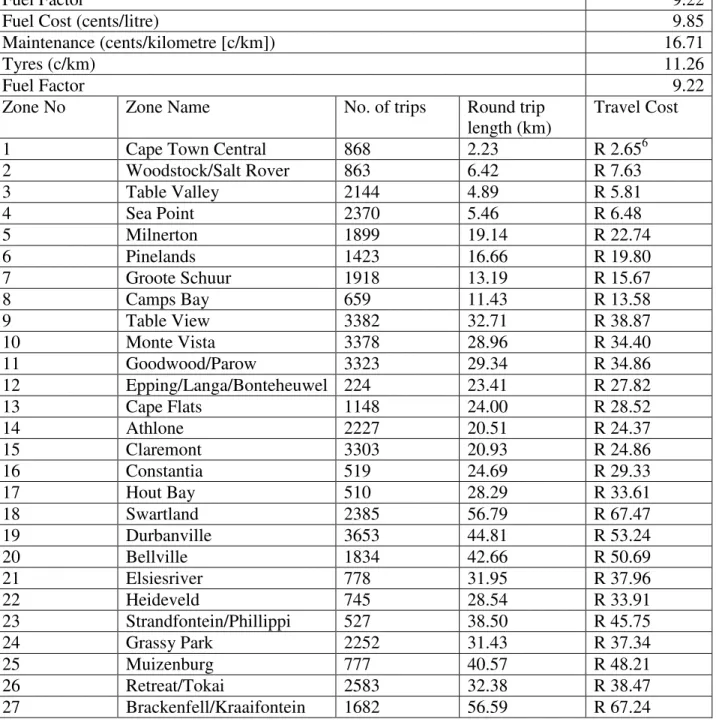
Chapter Summary
The type and extent of congestion charging that would be appropriate for Cape Town; and. The type of congestion charge was typically closely tied to the technologies available and required for charging and enforcement. For this particular study, public transport and emergency vehicles were exempted from the congestion charge.
Public transport vehicles were exempted because they could potentially pass on the cost of the charge to passengers and this would not encourage a modal shift. The results of the analysis of the available data, taking into account all other factors influencing, suggest that the introduction of an AM Peak congestion charge for a given cordon around the CBD would result in a reduction in traffic volumes, but that the city two fundamental challenges, namely the current public transport system and the socio-economic impact on middle and low incomes.
Hypotheses testing
The most viable technology that can be used at the moment is the ANPR system.
The payment system, which could be used, would be similar to London and would require no roadside equipment. The hypothesis that of the available Travel Demand Management strategies, congestion charging is technically suitable for Cape Town cannot be rejected.
Areas for further research
9 The sum of daily journeys from traffic zones 101 to 118, used in the case of conversion of daily journeys into vehicle journeys. Public Transport Study for the Cape Town Metropolitan Transport Area: Policy and Strategy Synthesis Report on Phase 2. Western Cape Transport Policy Green Paper, Cape Town: Department of Transport and Public Works, Western Cape Government.
She has worked on a number of transport schemes in Central London, which sparked her interest in travel demand management and congestion charging. Samantha is a member of the London Women's Transport Seminar and is a Construction Ambassador with CITB construction skills.
